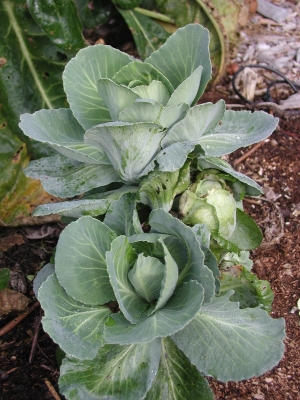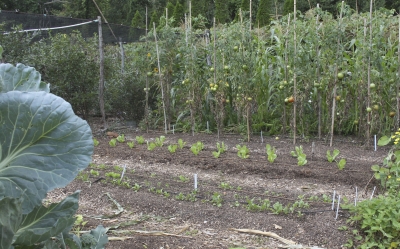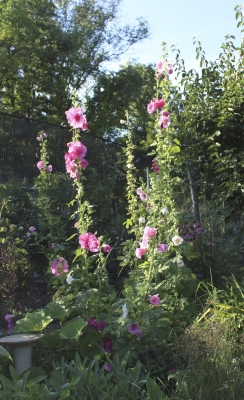Hormones Get Pumping
/5 Comments/in Books, Fruit, Gardening, Vegetables/by Lee ReichMore Brussels Sprouts, Cabbages, & Pears with Hormones
It’s time to get the hormones pumping. No, not by me embarking on some testosterone-fueled, garden-related feat of strength or endurance. Not even my own hormones, but the ones in my plants, more specifically my brussels sprouts plants. And actually, quashing the action of one hormone so that other hormones can come to the fore.
Let me explain: Brussels sprouts are not only a member of the cabbage family but are the same genus and species as cabbage, as are broccoli, cauliflower, kohlrabi, and kale. Differences in these plants lie in the way growth of the stems and leaves are expressed. Cabbage has a single stem that’s been telescoped down to very short internodes, resulting in a tight head of overlapping leaves. With kale, internodes along the stem are further apart, allowing each leaf to unfold fully on its own. They also look different from those of cabbage.
In every plant, a shoot bud develops in the upper part of the crotch where a leaf joins a stem. Most brussels sprouts buds each start to develop enough to form a small, cabbage like head. But I — and probably you also — want large brussels sprouts sprouts (and more of them, so I also want tall brussels sprouts plants on which to attach the sprouts).
The sprouts are retarded somewhat in their development by a hormone called auxin. Auxin is one of many plant hormones coursing about within leaves, fruits, shoots, and roots, their effect dependent on such variables as plant part, plant age, and what other hormones they are reacting with. One place of auxin synthesis is in the tips of stems, and their effect is to suppress growth of buds down along the stem, with more suppression the closer a bud is to the tip of the stem. I just looked at my brussels sprouts plants; yes, the largest sprouts are those nearest ground level. It’s still too early to harvest and too many of the upper sprouts, at present, are too small to be worth picking.
Suppressing auxin production in the tip of the stem releases their hold on the buds — that is, the sprouts — along the stem, so they can grow larger. Suppressing auxin production is simple, requiring only two fingers: Just snap off the tip of the stem. No tip, no auxin production, for a while, at least. The time to do this “operation” is the beginning of September. Done too soon, and a developing sprout might grow so bold as to grow out into, at worst, shoots or, less worse, loose heads. Plus, earlier in the season, I want to keep the stem elongating to provide real estate along which to hang more sprouts.
A Three-Headed Cabbage!
As I wrote, every plant develops buds in its leaf axils, and in every plant growth of those buds is mediated, in part, by auxin. Harvest the main head of broccoli and side shoots start to grow for eventual harvest.
Even tight heads of cabbage have those buds and they also respond to auxin’s influence. I used to plant cabbage in the spring for harvest in summer. Rather than pulling out the spent cabbage plants, as is usually done, I would leave the cut stump with a few bottom leaves for nourishment. Harvesting the cabbage dramatically removes the tip of the stem, which was buried within the head.
Within a couple of weeks, new sprouts would develop in the crotches where leaves were or had been. In the ideal world, I’d get one to three new cabbage heads from each plant, ready for autumn harvest. A certain amount of art was needed to get it right. Depending on growing conditions and the number of new heads I allowed to develop, they might end up too small or too loose-leaved.
I’ve abandoned that chancy cabbage habit and now do a second sowing of cabbage in early June for a reliable autumn harvest of firm heads.
Pears — More, Please
I fiddled around with hormones earlier this season also, with longer term goals in mind. Auxin keeps the tip of a stem or the upper portions of a plant growing most vigorously. Vigorous growth, though, is at odds with making fruit. After all, both require a lot of a plant’s energy, so the plant has to partition the energy efficiently between growing and fruiting.
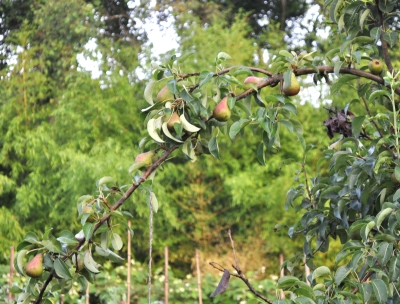 Pear trees are famous for growing vigorous shoots skyward. Yes, shoot growth is needed on which to hang fruit and for adequate leaves for photosynthesis. But enough is enough. Rather than pinch out shoot tips, which would likely just pass on the vigor to nearby lower buds, I bent ranches down and held them there with string. Changing stem orientation from vertical to at or near horizontal quells auxin production, slows growth, and promotes the formation of fruit buds along the stem. (Fruit buds form the year before flowers open.)
Pear trees are famous for growing vigorous shoots skyward. Yes, shoot growth is needed on which to hang fruit and for adequate leaves for photosynthesis. But enough is enough. Rather than pinch out shoot tips, which would likely just pass on the vigor to nearby lower buds, I bent ranches down and held them there with string. Changing stem orientation from vertical to at or near horizontal quells auxin production, slows growth, and promotes the formation of fruit buds along the stem. (Fruit buds form the year before flowers open.)
Fruits now dangle from some of the stems that I pulled down a year ago last spring. The response can take more than a year as energy reserves are redistributed within the stem. Response also depends on a tree’s inherent vigor, growing conditions for the season, the pear variety, the degree of stem bending, and other knowns and unknowns. It’s takes a mix of science, art, and experience, and that’s what makes gardening so interesting for me.
End of Summer? Enter the Fall Garden.
/2 Comments/in Gardening, Planning, Vegetables/by Lee ReichFading Summer Brings in Fall Greens, and Hollyhocks for Cheer
There’s a flurry of seed sowing and setting out of transplants going on here. Am I deluded that it’s springtime? No. Autumn is around the corner and there are vegetables to be planted.
For many gardeners, summer’s end and the garden’s end are one and the same. But planning for and planting an autumn vegetable garden bypasses the funereal look of waning tomatoes, peppers, cucumbers, and other vegetables that thrive only with summer heat and long days of sunshine, and puts plenty of fresh vegetables on the table. Having an autumn vegetable garden is like having a whole new garden, one that gradually fades in, like a developing photograph, as summer vegetables fade out.
Which is why today I tucked two dozen endive transplants into a double row of holes spaced fifteen inches apart in a three-foot-wide bed. And which is why, in a different bed two weeks ago, I sowed a row of Watermelon winter radishes (the resemblance to watermelon only in the color of their innards), a row of turnips, and a row of Chinese cabbage. Also, why back in March, seeds of Brussels sprouts were sown, the seedlings of which were transplanted to yet another bed last May.
Not that the time has passed for planting any autumn vegetables; plenty of vegetables that enjoy the cool moistness of autumn are still to be sown. This week, I plant to sow lettuce, spring radishes, arugula, mustard, and spinach.
Edamame Out, Endive In
The question might arise as to where to plant all these autumn vegetables when the garden is already overflowing with summer vegetables. Overflowing, really?
I planted the endive transplants in a bed that I had just cleared of edamame plants; edamame bear over a period of a couple of weeks and then they’re done, which they were. Likewise, a whole bed of onions and a first planting of corn are finishing up, freeing up space for planting. Even the bed from the second planting of corn will be freed up the end of August.
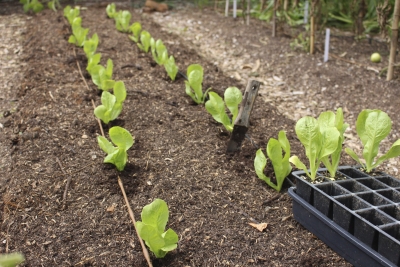
Harvest of bush beans does not halt as abruptly as that of corn, onions, or edamame. Nonetheless, the bean harvest does begin to taper down after two or three weeks, so out went the first planting of bush beans a couple of weeks ago. A second planting, sown in a different bed three weeks after the first planting, took up the slack, and today I’m pulling even those plants out of the ground. Pole bean plants will keep green beans on our plates until frosty weather, which it what it takes to put a stop those plants.
Can’t Help But Smile With Hollyhocks
My garden isn’t only about food. I’m also sowing some flower seeds now, not to blossom in autumn but to get a jump on next spring.
This past spring I sowed seeds of Apricot-Peach Parfait hollyhocks (from https://www.reneesgarden.com). Right now, the plants’ seven-foot-high spires are studded along their length with frilly blossoms in delicious shades of apricot and rosy-peach. I want more.
Hollyhock self-seeds so future population growth could be left to the vagaries of nature and weather. But overly diligent weeding or mulching might quash newcomers, so I’m going to sow more seeds. Hollyhock is a biennial or short-lived perennial so that self-seeding habit is welcome.
As either a short-lived perennial or biennial, hollyhocks tend to grow just leaves their first year and flower their second year — then die if they behave like a biennial, or go on to flower for more years if they are perennial. I was able to get flowers this season from spring-sown seeds because I planted the seed early and the seedlings spent their first few weeks of growth in the greenhouse. (Through breeding, some varieties of hollyhock behave as annuals, and bloom reliably their first year — but not as seven-foot-high spires.)
Planting the seed in late summer guarantees that the plants will bloom next year, and earlier than spring-sown plants. Cool weather of late fall and late winter helps trigger the flowering response.
Delphinium is another flower to sow this week. In addition to the advantages of enjoying spires of blue flowers earlier and more reliably next summer, delphinium seeds sprout more reliably if fresh, which they are more likely to be in autumn than the following spring. Chilling the dry seed — some sources suggest stratification, that is, chilling the moist seed — for a week or so also is said to help wake it up.
Once seedlings of hollyhocks and delphiniums get going, they’ll need special accommodations to get through winter. After all, they’ll still be tender, baby plants when the weather turns frigid. The goal is to keep them alive and growing slowly going into winter. I’ll either tuck the pots close together in the cold frame or in the slightly warmer large window in my barely heated basement.


